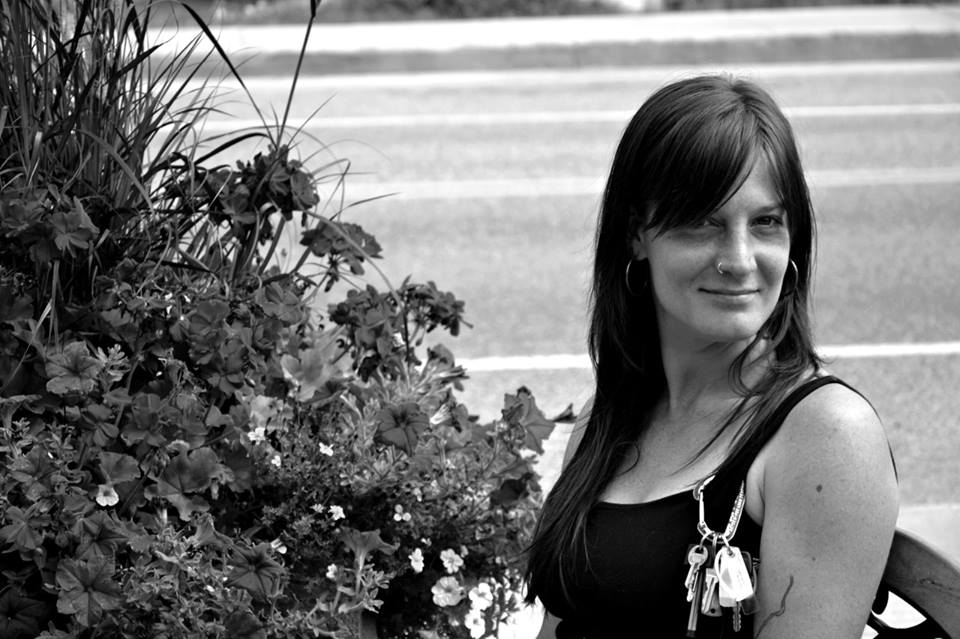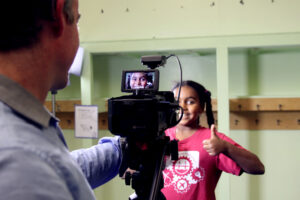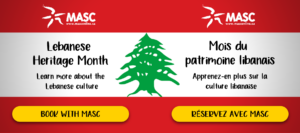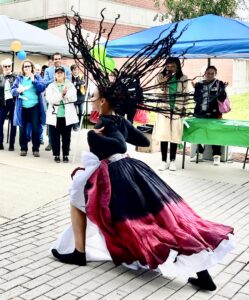Interview: Artist and educator Emily Rose Michaud creates bridges between art and life
By Jessica Ruano | January 5, 2022

This interview was originally published on Apt613.ca
Emily Rose Michaud is an interdisciplinary artist and educator working at the crossroads of community organization, ecology, and civic participation. Her work highlights the social importance of marginal landscapes, engages with land as a living entity, and maintains a practice in ephemeral media. In this article, Emily speaks about art, ecology, mental health, and why she finds bodiesof water so enticing.

Emily Rose Michaud leads a workshop. Photo provided by MASC.
MASC: Your work is strongly influenced by the natural world, and you’ve talked about your personal need to create work in nature “under open sky, by water, in wide open spaces.” What do you feel is the relationship between art and ecology, and how does that play out in your artistic practice?
Emily Rose Michaud: I’ve always created bridges between art and life. My beginnings were in painting and drawing, but I follow the medium that suits expression: land-based art; installation; raft; rural studio construction; nomadic residency. Since the mid-2000s, my art practice has shifted outdoors, to be more in sync with the natural world and to make spaces that allow me to approach the world from a place of embodiment, stillness, and wonder. I was guided by a lineage of land artists who emerged from the gallery scene of Manhattan in the ’70s to explore physical immersion in the landscape, ephemeral art, and non-commercial art.
When I slow down, a new world opens up. Co-authorship and interconnectedness is deeply tied to the world and works I am looking to create, whether it is collaborating with little humans, older humans, or non-humans. Learning comes from curiosity and deepening into relationship with the places we find ourselves in and the folks we are surrounded by.
Re-enchantment with the natural world motivates me to shift my listening, observing and relating, so this is why I perceive art and ecology to be totally connected. Modern views of nature distance us by feeding the illusion that we are separate from life, that we are independent entities, when we are in fact completely interdependent upon our living environments. Human cultural activity IS nature. In 1866, German biologist Ernst Haeckel coined the term ecology when he defined it as “the comprehensive science of the relationship of the organism to the environment.” I practice art as a way to be in relationship – to both environment and self.

Working on art at Maurice Lapointe High School in 2019. Photo provided by MASC.
Your latest project was an homage to the Ottawa River watershed as well as bodies of water from Almonte to Maniwaki. What is it about water that you find so enticing? And how has this project changed the way you view Algonquin Territory (Ottawa/Gatineau)?
Tributaries was a solo interdisciplinary exhibit that transformed me as much as my relationship to the watershed. I’m drawn to water as a universal conductor and gathering place of life. Tributaries drew on local and regional experiences of hydro power, watersheds, water bodies, dams, and water flows and incorporated historical elements related to immigrant labour and the wool industry of Almonte. I road-tripped to many different sites and communities within the bio-region to develop my sense of the territory, its spirit and history. Water is alive and represents consciousness to me.
Like a drop of water, we have impact within our collective. We can’t afford to be on standby as the war wages on in our own backyards each day. The difference we make can emerge in our very embodiment of values that are learned directly through relationship building, meaningful conversations, visits with the water. The difference we can make is carried in the remembrance within our own bone lineage. Fighting to keep the holy, living world intact in a world that too often forgets to remember.
As a member of MASC, what do you gain through offering your workshops in schools and in the community?
I feel honoured to be a member of the MASC team – their allyship, leadership, encouragement, and support means the world to me at this uncertain, unique, changing time. Over the years as an independent educator, the work as a self-employed gigger can be isolating and overwhelming. I’ve loved the opportunities and communities that have been made possible for me because of the MASC artists and team doing such incredible work for the arts community.
Why do you think it’s important for our local community to have access to professional artists?
As a kid growing up in this region, the lack of access to quality arts and culture was what led me to leave home after high school to pursue an arts education in Montreal. The resources weren’t available, so I worked hard to make that opportunity possible for myself. Not everyone has the chance or privilege to leave their community. I think it’s an absolute priority to offer living examples of local professional artists to the community because it inspires, connects, and opens doors and possibilities for more culture to take root. Where strong culture dwells, healthy communities gather.

Getting creative. Photo provided by MASC.
Your new online program with MASC invites participants to create artwork inspired by water molecules. In particularly difficult times, such as this pandemic, what role can art play in connecting us to nature and to ourselves?
The role that art and nature have to play on mental health and well-being right now cannot be highlighted enough. In the water molecule workshop, participants create a six-sided hexagon with a centre pattern – something observed in biology, geology, chemistry, physics and astronomy – and use drawing and sketching to understand more about water. Youth participants create something that brings them fun, focus, and relaxation – the activity engages their senses through line, colour, pattern, and emphasis on personal expression.
Without such moments to unwind, we become accustomed to reacting to everything our external environment throws our way. Taking time to slow down, returning to our senses, and connecting to something creative within, will have an impact on how we navigate the coming months. A return to normal after this pandemic is unlikely, but if we can strengthen our capacity to enact our lives from a place of creative power, pleasure and wonderment in the mundane, we will develop resilience to survive the storm.
Latest News
View All Articles



